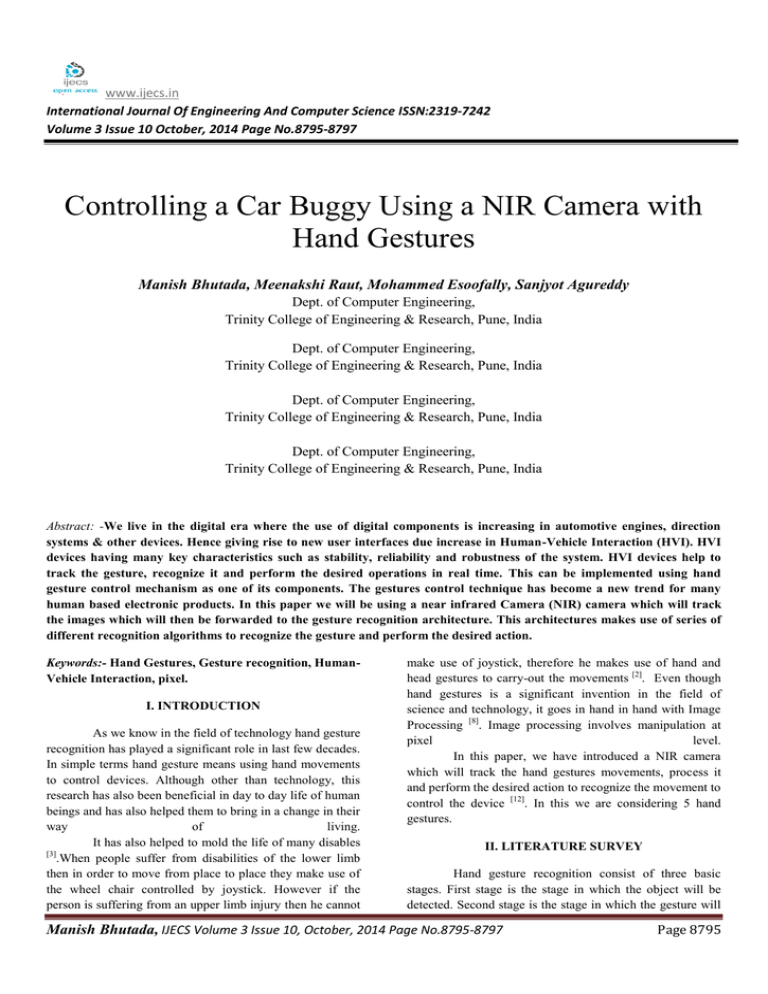www.ijecs.in International Journal Of Engineering And Computer Science ISSN:2319-7242
advertisement

www.ijecs.in International Journal Of Engineering And Computer Science ISSN:2319-7242 Volume 3 Issue 10 October, 2014 Page No.8795-8797 Controlling a Car Buggy Using a NIR Camera with Hand Gestures Manish Bhutada, Meenakshi Raut, Mohammed Esoofally, Sanjyot Agureddy Dept. of Computer Engineering, Trinity College of Engineering & Research, Pune, India Dept. of Computer Engineering, Trinity College of Engineering & Research, Pune, India Dept. of Computer Engineering, Trinity College of Engineering & Research, Pune, India Dept. of Computer Engineering, Trinity College of Engineering & Research, Pune, India Abstract: -We live in the digital era where the use of digital components is increasing in automotive engines, direction systems & other devices. Hence giving rise to new user interfaces due increase in Human-Vehicle Interaction (HVI). HVI devices having many key characteristics such as stability, reliability and robustness of the system. HVI devices help to track the gesture, recognize it and perform the desired operations in real time. This can be implemented using hand gesture control mechanism as one of its components. The gestures control technique has become a new trend for many human based electronic products. In this paper we will be using a near infrared Camera (NIR) camera which will track the images which will then be forwarded to the gesture recognition architecture. This architectures makes use of series of different recognition algorithms to recognize the gesture and perform the desired action. Keywords:- Hand Gestures, Gesture recognition, HumanVehicle Interaction, pixel. I. INTRODUCTION As we know in the field of technology hand gesture recognition has played a significant role in last few decades. In simple terms hand gesture means using hand movements to control devices. Although other than technology, this research has also been beneficial in day to day life of human beings and has also helped them to bring in a change in their way of living. It has also helped to mold the life of many disables [3] .When people suffer from disabilities of the lower limb then in order to move from place to place they make use of the wheel chair controlled by joystick. However if the person is suffering from an upper limb injury then he cannot make use of joystick, therefore he makes use of hand and head gestures to carry-out the movements [2]. Even though hand gestures is a significant invention in the field of science and technology, it goes in hand in hand with Image Processing [8]. Image processing involves manipulation at pixel level. In this paper, we have introduced a NIR camera which will track the hand gestures movements, process it and perform the desired action to recognize the movement to control the device [12]. In this we are considering 5 hand gestures. II. LITERATURE SURVEY Hand gesture recognition consist of three basic stages. First stage is the stage in which the object will be detected. Second stage is the stage in which the gesture will Manish Bhutada, IJECS Volume 3 Issue 10, October, 2014 Page No.8795-8797 Page 8795 be recognized. The third stage is the stage in which it will analyze the gestures in a sequential manner to identify the instructions. To detect hand objects in the digital images is the sole purpose of the first stage. To achieve recognition accuracy, the most common image problems which include noise, contrast, poor resolution and unstable brightness should be solved in this stage. In the second stage object recognition is programmed to differentiate between the operator image and the obstacle image. Obstacle image can be any image or hand gestures in the background. In the third stage the analysis of the gestures will be done using various algorithms to perform respective actions. III. SYSTEM ARCHITECTURE In our system we have proposed hand detection and recognition and on the basis of this required data is fetched from the database. This data is then responsible for the movement of the device using a Radio Frequency Transmitter (RFT) that are sent to Radio Frequency Receiver placed on the device. IV. PROPOSED SYSTEM There are many environmental conditions which are proposed in this paper which assure the good performance of the system. Stage 1: Detection of Object Stage 2: Gesture Recognition Stage 3: Instruction to perform Figure 1: Gesture Recognition stages Likewise hand gesture recognition has made a drastic change in robot navigation problems, where handling the big robots over voice command was difficult, due to introduction of the hand gestures it became quite simple as only simple hand movement are required to control the robot. For example, we are using certain gestures to control the device. For robot handling various hand gestures given in figure can be used. a. Gesture recognition system can be built using this proposed system which can be utilized as an indoor or invehicle system. b. Camera captures the images that are in front of it. c. The background of the hand image is made blur and a blob of the hand is created. According to our system, image capturing is done in quite easy way and interface is very user-friendly. The image is grabbed using an NIR camera, this obtained image is converted from RGB model to Hue Saturation Value Model (HSV), and then HSV-Thresholding is applied to it. The image obtained is then blurred to reduce the noise from the background. After the thresholding the Blob is obtained which only consists of the required image. Vector calculation are performed considering the Center of Gravity (COG). The translation of the hand from one portion of the screen to the other helps the system to recognize the gesture movement. Image Grab RGB -> HSV conversion HSV Thresholding (a) (b) (c) Blur Blob Detection Gesture Recognition (e) (f) Figure 2: Images of Gesture Recognized by the system In the above fig. 2 are mentioned the images of the gestures that are recognized by the system that are (a) Move (b) Stop (c) Reverse (d) Turn Right (e) Turn Left. Manish Bhutada, IJECS Volume 3 Issue 10, October, 2014 Page No.8795-8797 Output Figure 3: System Flow Page 8796 ACKNOWLEDGEMENT We here taking the opportunity in thanking all the people who helped is for completing out project, it would not have been possible to complete this project without them. Firstly we would thank our utter supportive guide, Prof. Anup H. Raut, for their ever ending guidance at all times and providing the guideline without any complaints at any time and also all of the ideas and effort they put into our project. We would also like to thank Prof. S. B. Chaudhari (HOD Comp.) for his interest & co-operation for the project. Expressing our sincere gratitude to TCOER, Pune, for providing us the facilities like Library & Internet. Also thanking all the people who have helped directly or indirectly in completing our project. REFERNCES 1. B. Ionescu, V. Suse, C. Gadae, B. Solomon, D. Ionescu, S. Islam & M. Cordea, "Using a NIR Camera for Car Gesture Control" in preceding IEEE Latin America Transaction Vol. 12, No. 3 May 2014. 2. Fang Wang, Jinhua Zeng & Yaoru Sun "Natural hand gesture for intelligent human-computer interaction and medical assistance". 3. Helman Stern1, Juan Wachs1, Yael Edan1, Michael Gillam2, Mark Smith2, Craig Feied2, Jon Handler2 “A Real-Time Hand Gesture Interface for Medical Visualization Applications” 4. Basic 3D Interaction Techniques in Augmented Reality Aciek Ida Wuryandari, Yoki Ariyana,, School of Electrical Engineering and Informatics InstitutTeknologi Bandung Bandung, Indonesia. 9. P.A. Cabarcos, , F.A. Mendoza, R.S. Guerrero and D. Díaz-Sánchez A. Marín López, “FamTV: An architecture for presence-aware personalized television,” IEEE Transactions on Consumer Electronics, vol.57, no. 1, pp.613, 2011. 10 M. Pantic, A. Vinciarelli, and H. Bourlard. “Social signal processing: survey of an emerging domain,” Image and Vision Computing Journal, vol. 27, no. 12, pp. 1743-1759, 2009. 11. J. Little and W. James, Simultaneous tracking and action recognition using the PCA-HOG descriptor, in Proc. of the Third Canadian Conference on Computer and Robot Vision, pp. 6, 2006. 12. L. Gorelick, M. Blank, E. Shechtman, M. Irani, and R. Basri, Actions as space-time shapes, IEEE Trans. Pattern Analysis and Machine Intelligence Vol. 29, No. 12, pp. 2247–2253, 2007. 13. S. Calderara, R. Cucchiara, and A. Prati, Action signature: A novel holistic representation for action recognition, in Proc. of the International Conference on Advanced Video and Signal Based Surveillance, IEEE Computer Society Press, Washington, pp. 121– 128, 2008. 14 C. Schuldt, I. Laptev, and B. Caputo, Recognizing human actions: a local SVM approach, in Processing of International Conference on Pattern Recognition, Vol. 3, IEEE Computer Society Press, Cambridge, UK, pp. 32–36, 2004. 15. J. Davis and M. Shah “Visual Gesture Recognition", IEE Proc.-Vis. Image Signal Process. Vol. 141, No.2, April 1994. 5. F. Kishino and A. Utsumi, T. Miyasato, "Multi-Camera Hand Pose Recognition System Using Skeleton Image", pp. 219-224, 1995. IEEE International Workshop on Robot and Human Communication, 6. Ching-Hao Lai ‘Smart Network System Institute Institute for Information Industry’, Taipei City, Taiwan “A Fast Gesture Recognition Scheme for Real-Time HumanMachine Interaction Systems” 7. Yaoru Sun, Jinhua Zeng, and Fang Wang Brunel University Uxbridge UB8 3PH, United Kingdom. “A natural hand gesture system for intelligent human-computer interaction and medical assistance” 8. S. Davidoff, M.K. Lee, J. Zimmerman, and, A. Dey, “Socially-aware requirements for a smart home,” In Proceedings of the International Symposium on Intelligent Environments, p. 41-44, 2000. Manish Bhutada, IJECS Volume 3 Issue 10, October, 2014 Page No.8795-8797 Page 8797





